Introduction
According to NASA’s Critical Path Roadmap (1), the most critical biomedical risks of space habitation are (1) carcinogenesis caused by radiation, (2)loss of bone mass or density, (3) poor psychosocial adaptation, and (4) clinical manifestations of trauma or acute medical problems. Because of the unique problems and the potential long-term consequences, radiation is frequently considered the most serious of these for long-duration space missions, and cancer is the major risk followed by damage to the central nervous system. Radiative hazards in space have been discussed in depth by a Task Group of the National Research Council along with overall research strategies (2).
The term radiation in the present context refers specifically to directly and indirectly ionizing radiation, including X rays, gamma rays, neutrons, ions, and other somewhat esoteric particles such as muons and pions. Radiation is a natural part of our environment on the surface of Earth. We are constantly being bombarded with radiation from our own Sun and from outer space. In fact, X rays and gamma rays are part of the electromagnetic spectrum to which we are exposed daily that includes infrared radiation (heat), visible light, and ultraviolet radiation as well as higher energy X rays and gamma rays. Radioactive elements also are naturally present in essentially all of the materials that surround us as well as those of which we are composed. Biological organisms in general, and humans in particular, have adapted to the normal radiative environment at Earth’s surface and certainly have even benefited from the radiation. At the same time, those radiations also initiate biological damage ranging from sunburn to cancer. Earth’s atmosphere and its magnetic field act as excellent radiative shields by reducing the levels of radiation. As we go farther away from Earth’s surface into orbit or toward outer space, the radiative level generally increases in intensity and changes in the types and energies of the radiation. It is known that the radiative dose rates for personnel in space are significantly higher than on Earth’s surface. We have had little experience with regard to the biological consequences of healthy people exposed to these types of radiation for protracted periods of time. Our best estimates indicate, however, that the additional exposure to higher energy radiation beyond that on Earth’s surface or above the present allowable limits for radiation workers could result in significant risks of cancer or other serious diseases.
Because of higher level of exposures and the potential for long-term negative consequences, radiation has been categorized as the worst biomedical risk of long-duration space missions. At the same time, using an appropriate programmatic strategy and focused research, the risks of radiation in space should be reduced to levels comparable to or less than those of other hazards.
Radiative Fields
Individuals in orbit around Earth or on space missions are subjected to three major sources of radiation: (1) particles trapped in Earth’s magnetic field (4), (2) radiation emanating from solar events, and (3) galactic cosmic rays. Each of these radiative fields has unique distributions of particle types and energies at fluence rates (number of particles per unit area) of varying intensity, but generally higher than those at Earth’s surface. Trapped Radiation
Electrons. When subjected to an external magnetic field such as that surrounding Earth, charged particles spiral around the magnetic field lines. Thus charged particles, particularly protons and electrons, accumulate in significant numbers around Earth along the magnetic field lines. Figure 1 shows a typical frequency distribution of the number of electrons as a function of their energy (5). Because of the relatively low energies of these electrons, they are absorbed by spacecraft or space-suit materials and are not likely to represent a major source of exposure for personnel in Earth orbit.
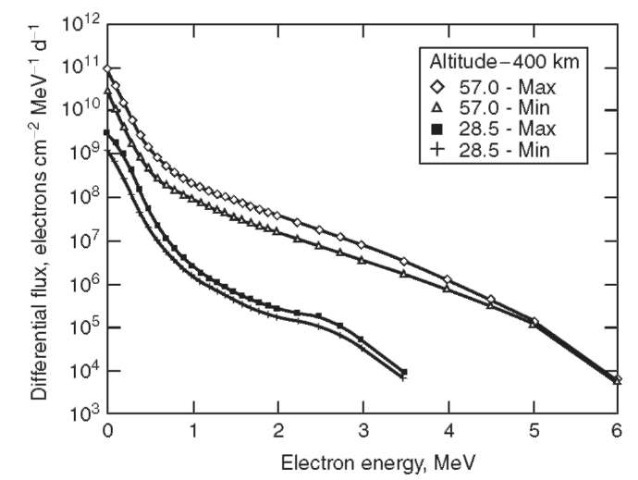
Figure 1. Trapped-belt electron spectra at 400 km for solar minimum and maximum inclinations of 28.5° and 57° using AE-8 environment model.
Trapped Protons. A typical distribution of protons trapped in Earth’s magnetic field (5) is shown in Fig. 2. Because of the higher energy and higher mass of these particles, they can deliver a significant dose to personnel who spend long times in orbit.
Solar Events. The Sun, operating largely as a result of nuclear fusion, is the major source of energy in our solar system. Although the rate of energy from the Sun is relatively constant, anomalous activities arise locally and stochastically, and these events can be major sources of radiation, especially higher energy protons. Figure 3 shows distributions of protons emanating from an exceptionally intense solar event as a function of time and the energy of the protons (6). Note that the fluence was delivered during an extended period of several hours. These protons can penetrate significantly and can produce substantial biological damage if left unchecked. They have, however, relatively low energies, so appropriate shielding can significantly reduce the doses and, presumably, the biological consequences. Additionally, although the occurrence of a specific solar event is somewhat stochastic, the number of such occurrences per unit time is cyclic, and the period is about 11 years. So the cyclic nature of solar events is something that may be used to minimize exposure. However, the fluence rate of galactic cosmic rays actually decreases during maximum solar activity, so the best scenario for minimum exposure is not necessarily during solar minimum.
Galactic Cosmic Rays
Galactic cosmic rays generally originate from activities within our galaxy during millions of years. As a group, these particles have the most energetic radiation and, therefore, are the most penetrating and the most difficult to shield. They consist primarily of protons and, to a lesser amount, helium ions; only a small fraction of ions has higher atomic numbers. The probability per logarithmic interval in kinetic energy per nucleon, kEfE), as a function of the kinetic energy E for four ions is given in Fig. 4. These particles have the highest energies of space radiation and have modal values of about 1GeV (1GeV is 109 electron volts, where an electron volt is the energy gained by one electron accelerating through a potential of one volt). The energetic ions with atomic numbers greater than that of helium are frequently called HZEs, i.e., heavy ions (H) with high atomic numbers (Z) and high energy (E).
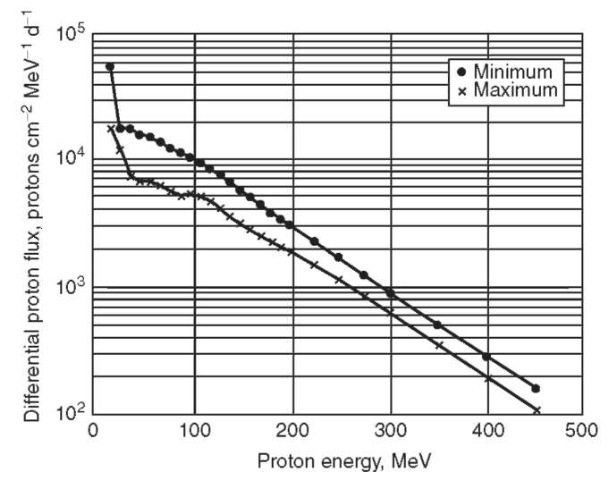
Figure 2. Trapped-belt proton spectrum for the ISS orbit (51.6° inclination, 470 km altitude) using AP-8 models for solar maximum and minimum.
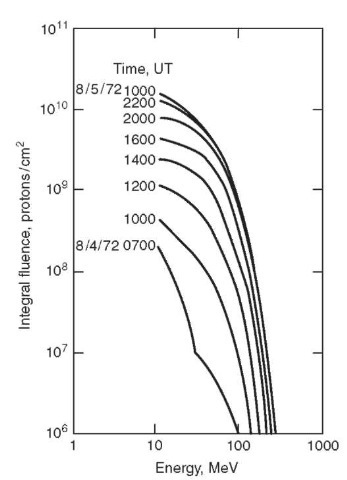
Figure 3. The proton fluence as a function of time and energy of a solar event in August 1972.
Radiation on the Moon and on Mars
The radiative levels on the surfaces of both the Moon and Mars are reduced by their partial directional shielding and, in the case of Mars, the shielding provided by the Martian atmosphere. In both cases, the radiative fields are expected to be between those observed on Earth’s surface, where its thickest atmosphere and greatest mass are, and those of deep space. It is estimated that radiative doses on the Moon are about half as intense as those in outer space (7). The same estimates for the Martian surface are significantly lower than in free space or on the surface of the Moon. Although higher than at Earth’s surface, they could be within acceptable ranges for radiation workers, especially if the existing regolith were used for shielding.
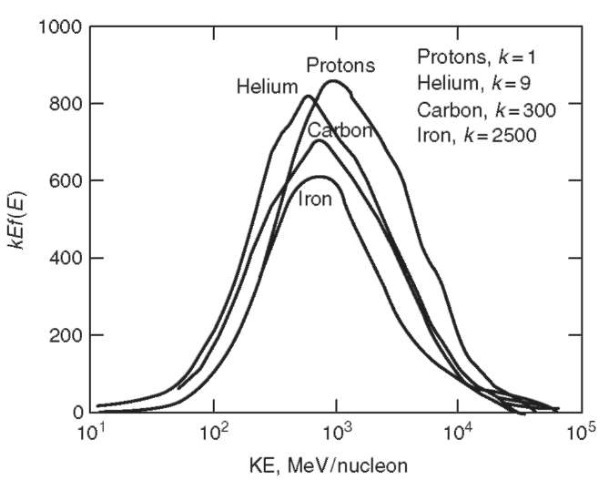
Figure 4. The differential probability per logarithmic interval in kinetic energy per nucleon, kEf(E), as a function of the kinetic energy E for four ions. f(E) is the linear differential probability for a particle of kinetic energy E. k is the scaling factor given in the legend. In this representation, the area under the curve between two values of E is proportional to the number of particles in that interval.
Estimation of Doses from Radiation
During the last two decades, our knowledge of the types of individual particles present in the different radiative fields to which astronauts are likely to be exposed and their variation in time has improved considerably as a result of dedicated research efforts throughout the world. Concurrently, data to determine the doses to which the astronauts would be exposed were also obtained. The net result is that estimates of exposure levels are significantly more accurate, compared with earlier values, as are the corresponding doses for likely situations in space. Terminology. The dose D is the energy deposited by radiation per unit mass of the absorbing medium [1 joule/kg = 1gray (Gy) or 100ergs/g = 1rad]. It is sometimes called physical dose or absorbed dose to differentiate this quantity from other related quantities such as dose equivalent.
The relative biological effectiveness (RBE) is the ratio of the dose from a reference radiation, usually X or gamma rays (g), to the dose from the radiation being studied to produce the same level of biological response (RBE = Dreference/Dstudied).
In health physics, the term radiative quality Q is used for risk assessments and to establish the relative risk from different types of radiation or different energies. The unit for radiative quality is sieverts per gray (Sv/Gy). Analogous to the RBE, Q is a factor by which the physical dose is multiplied to obtain the dose equivalent to that of the reference radiation, usually X or gamma rays. The RBE is generally used as a research quantity to express relative effectiveness, whereas radiative quality is more often used in a regulatory manner for risk assessments.
The dose equivalent DEQ, then, is product of the physical dose and the quality factor for a specific type of radiation (Deq = QFD). Thus, it is the dose of the reference radiation which produces the same level of risk as the actual physical dose. The units are sieverts (Sv). The definition of dose equivalent intrinsically assumes that the physical properties of the dose D and the biological properties of the radiative quality Q are independent and multiplicative. Therefore, the relationship, further assumes that dose equivalent is linear with dose. None of these assumptions is necessarily true, and, therefore, Q is a function of dose, irradiative time, and other parameters.
Differences in biological response or risk of diseases for the same absorbed dose arise in part because particles of different energies, charge, or mass deposit energy differently as they traverse a given path length through the material. To quantify those differences, we define linear energy transfer (LET or L) as the energy lost by the particle per unit path length (MeV/m or keV/um).
Dose and linear energy transfer are macroscopic quantities in the thermo-dynamic sense and, as such, apply only to large masses in equilibrium conditions. Many relevant biological processes take place at the cellular or molecular level. For these conditions, quantities such as dose or LET should not be applied because major errors result in some cases when this is inappropriately done. An entire field known as microdosimetry describes these microscopic and submi-croscopic quantities and processes (8-11). To describe the stochastic process analogous to the macroscopic quantity LET defined in the previous paragraph and to differentiate between the macroscopic and microscopic processes, we define the quantity lineal energy y as the microscopic energy deposited per unit path length in units of keWum.
Doses from Environmental Sources. Radiation is an intrinsic and natural part of our environment. Radiation from the Sun is the major source of energy for Earth and has many positive consequences. At the same time, this same energy can produce undesirable consequences ranging from sunburn to cancer. Nevertheless, because we generally assume that average levels of exposure from natural sources are acceptable, these levels represent a good baseline for comparison. Table 1 (12) lists typical sources of radiation and their contributions to exposures of the U.S. population, at a total dose equivalent of about 0.4 cSv. The actual dose is a strong function of elevation and location and can easily vary from this value by factors of two or more. Naturally occurring radon gases account for more than half of the dose equivalents, and cosmic radiation and other natural sources account for about a quarter of the dose equivalent. Medical applications and other man-made sources account for less than 20% of typical exposures.
Table 1. Recommended Limits on Dose Equivalent
| ICRP | NCRP | |
| Occupational | ||
| Annual | 5cSva | 5 cSv |
| Lifetime (cSv) | — | Age6 |
| Emergency | 10 cSv | 10cSv |
| Public | ||
| Annual (continuous) | 0.1 cSv | 0.1 cSv |
| Annual (occasional) | 0.5 cSv | 0.5 cSv |
Because the annual dose from natural sources hovers at about 0.3 cSv, it is not coincidental that the recommended upper limits for dose equivalents to the general public are typically between 0.5 and 0.1 cSv. Recommendations of two major institutions, the National Council on Radiation Protection and Measurements (NCRP) mentioned earlier and the International Commission on Radiation Protection (13) are compared in Table 2 (adapted from Reference 12). Occupational limits are generally allowed to be about a factor of 10 higher than those for the general population based on the strong stipulation that exposures should be kept as low as reasonably achievable, known as ALARA (14).
Most of our data for medical complications that result from exposures to radiation higher than the natural background come from either medical diagnostics or treatments, accidental exposures, or observations of survivors of nuclear explosions (15). Several decades of work have gone into medical evaluations and analyses of these latter individuals, and these data form the major source of information about risks from environmental exposures. These data must be used with care, particularly in space applications, because the atomic bomb exposures were acute exposures of a specific population under extreme conditions. Other human results along with animal and cell studies have been used to extend these results to estimate risks for humans in space (see Table 3). Two excellent reports by the National Council on Radiation Protection and Measurements go into details of both the analyses and the application to radiative protection in space (7,12). For the present discussion, the most important single quantity for comparative purposes is the overall risk per unit dose equivalent. The value, even of that quantity, varies with gender, age, and biological end point. Generally, cancer is considered the single most likely risk from radiation exposures in space. The overall probability that an individual will develop cancer in the United States is 1 in 2 for males and about 1 in 3 for females (16). Typically, the risk factor in adults for fatal cancer from radiative exposure is about 4 x 10 – 2 Sv -1 (7, p. 137). Therefore, the recommended upper limits correspond to a fractional increase ofa few percent in lifetime risk of fatal cancer.
Table 2. Annual Effective Dose Equivalent3′”
| Source | Persons exposed | Avg. annual dose equiv., cSv | Avg. annual dose equiv. In US pop., cSva |
| Natural sources: | |||
| Radon | 230,000,000 | 0.2 | 0.2 |
| Other | 230,000,000 | 0.1 | 0.1 |
| Occupational | 930,000 | 0.23 | 0.0009 |
| Nuclear fuel cycle | — | — | 0.00005 |
| Consumer products | 170,000,000 | 0.005-0.03 | 0.005-0.013 |
| Misc. envir. Sources | -25,000,000 | 0.0006 | 0.00006 |
| Medical | — | — | 0.053 |
Table 3. Estimated Doses for Space Activities

Doses and Dose Equivalents for Orbital and Interplanetary Missions.
Two important aspects of the assessment of risks from radiation in space remain to be considered: the exposure levels from radiative fields in space and the corresponding risks from those exposures. To address the first issue, measured values of Deq for previous space flights are plotted in Fig. 5 (17). Except for the Apollo missions, these represent relatively short orbital missions compared with either the international space-station or interplanetary missions. Except for the geosynchronous Earth orbit, all of the scenarios result in dose equivalents in the neighborhood of roughly 0.1 cSv per day.
Estimates of True Risk and Associated Uncertainties. As the radiative fields in space environments have continued to be characterized with increasing certainty during the last two decades, we have been able to proceed with estimates of the dose equivalents with increased confidence in the physics. However, the risk estimates continue to exceed established limits, and the errors of such analyses still remain at unacceptable levels for two major reasons:
1. Secondary particles: Although the primary spectra for galactic cosmic rays have been established with reasonable certainty, the variation in the radiative quality within a spacecraft remain both substantial and uncertain because of complex secondary reactions that produce neutrons and secondary charged particles.
2. Biological uncertainty in true risk: Dose equivalent may not represent the true risk of cancer and other diseases in a space environment. Because the particles responsible for radiative damage are more energetic and have greater mass than those encountered at Earth’s surface, our experience with this type of radiative environment is severely limited.
Secondary Particles. Figures 6 and 7 present the frequency distribution y2f(y) per logarithmic interval of lineal energy y for cobalt-60 gamma rays (18),250-MeV protons, 250-MeV/nucleon heavier ions, and neutrons at several energies (18). In the early era of research on risks from radiation in deep space, it was thought that the high-energy heavier ions such as iron were the most biologically damaging and, therefore, the most significant despite their lower abundance. Although protons and helium ions are about a thousand times more abundant, they are sparsely ionizing, that is, have low LET. They were expected to have a biological effect equivalent to that of X or gamma rays. The higher lineal energies from heavier ions of the same energy per nucleon result from a higher ionization density along the tracks. The early conclusion of some researchers was that the increased ionization density or higher LETs of these heavier particles would result in their being biologically more damaging despite their lower abundance. Typical distributions of secondary particles for 800-MeV protons traversing silicon were calculated by J.F. Dicello et al. and others (19). The group of Miller et al. has been measuring the distributions of primary and secondary charged particles produced by energetic heavy ion beams. Although the primary energetic protons are themselves close to minimally ionizing, they produce an abundance of secondary particles, as they traverse the spacecraft or its occupants. These secondaries include an abundance of lower energy protons, neutrons, and ion recoils, and many can be at least as highly ionizing as primary galactic cosmic rays and biologically as effective as primary HZE particles.
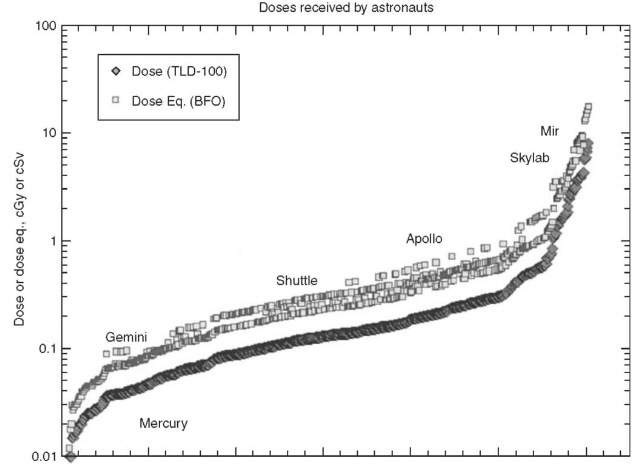
Figure 5. The dose in centigrays and the dose equivalent for blood-forming organs (BFO) in centisieverts for individuals in space
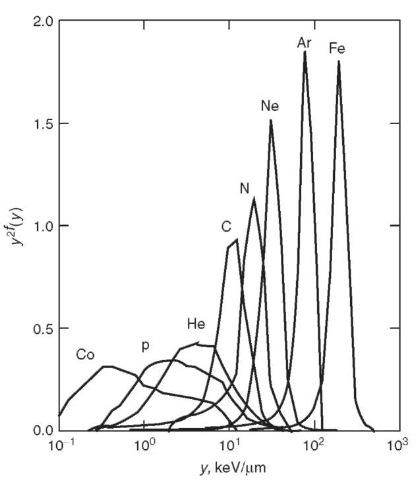
Figure 6. The probability per logarithmic interval of lineal energy y2f(y) as a function of lineal energy y for gamma rays from cobalt-60, protons of about 200 MeV initial energy, and heavier ions of about 600 MeV per nucleon
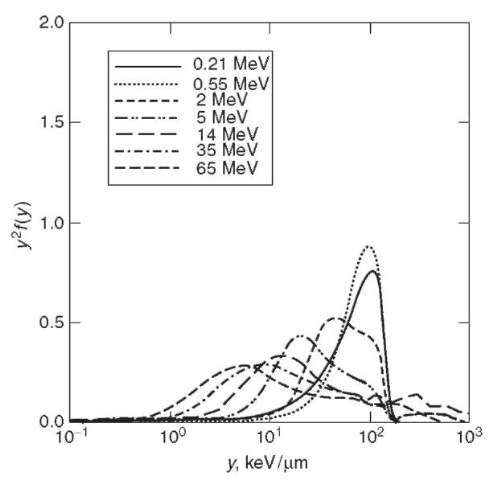
Figure 7. The probability per logarithmic interval of lineal energy y2fy), as a function of lineal energy y from external neutron beams of various specified mean energies
Based upon the microdosimetric analysis of the primary and secondary particles from galactic cosmic rays, Dicello (20) proposed that primary protons, along with their secondary charged particles and neutrons, might be at least as effective biologically as heavy ions in producing biological damage. The relative doses and dose equivalents expected as a function of depth are presented in Fig. 8 and show that, as the primary protons enter the spacecraft, they would rapidly produce secondaries and become major contributors to the dose equivalent at typical depths in a space vehicle. A major emphasis of current research is to choose materials that can minimize the number of primary HZE particles and also the substantial number of secondaries, particularly secondary neutrons. Despite the gradual change in the premise underlying the research and design, there is little biological data to evaluate any hypothesis.
Biological Uncertainty in True Risk. Although the dose equivalent can be calculated with a reasonable degree of confidence, it remains a major issue as to how accurately the quality factors used to obtain dose equivalent from the physical dose truly represent the actual biological RBEs for cancer or other major diseases. The change in the quality factor as a function of LET remains somewhat arbitrary in radiative protection. We will adopt the relationship described in NCRP 132 (7) and ICRP 60 (13) as the defined relationship for regulatory purposes; however, note that this relationship may not necessarily provide either the correct functional dependency with dose or LET or the correct absolute values within acceptable limits of uncertainty (17). Historically, the relationship between the quality factor and the LET was based initially on animal studies at high doses and cellular end points, primarily in vitro survival. Although NASA and other agencies have carried out a life-sciences research program to address these specific issues, to date, only one comprehensive study of carcinogenesis for HZE particles, that of Alpen et al. (21) and Fry et al. (22), has been completed. Fry et al. estimated RBEs for the different particle types at the lower doses of interest for space applications by taking the ratio of the estimated initial slopes of the dose response curves. This group studied the prevalence of tumors that arise in the Harderian gland in the ocular system of mice as a function of particle type and energy. Some of the results are presented in Fig. 9. Their analysis of the results produced RBEs of 27 for iron ions and 4 for helium ions. More recently, Dicello et al. (24) have been measuring the lifetime incidence of breast cancers that arise in a rat model from photons, protons, and iron ions. A large fraction of the animals is still alive, but preliminary results suggest RBEs somewhat lower than those observed by Alpen’s group for the Harderian gland.
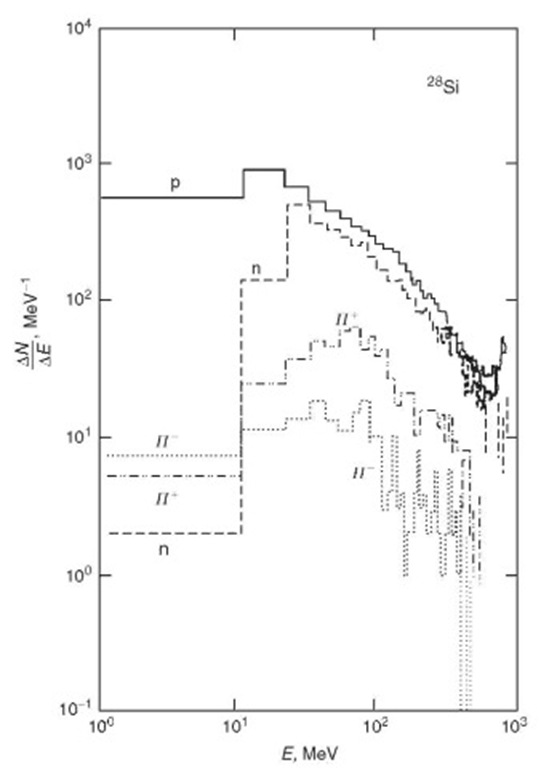
Figure 8. Number of secondary protons, neutrons, and pions per unit energy interval arising from nuclear cascade processes of 800-MeV protons in silicon
Countermeasures
Cucinotta et al. (17) attempted to evaluate how well the relationship proposed by ICRP and NCRP conforms to existing data and how much uncertainty still exists in proposed scenarios. The result of one error analysis as a function of depth in aluminum is presented in Fig. 10. The range of the vertical bars represents the range of probabilities that cancers will arise from exposures in space that remain likely because of the uncertainties of the measurements and calculations. There is one major conclusion that might be drawn for this study. The uncertainties in the existing data suggest that about 80% of the risk uncertainties result from uncertainties in the quality factors, that is, uncertainties in the relative effectiveness of the different radiations in inducing fatal cancers or other serious diseases. This translates to uncertainty in in vivo biological responses, as it relates to human diseases, which further translates into risk factors for potential design criteria, as illustrated in Fig. 11. Cucinotta et al. (17) conclude that the range in values likely for the probability for cancer is as much as a factor of five or more from the mean in specific regions (17,23).
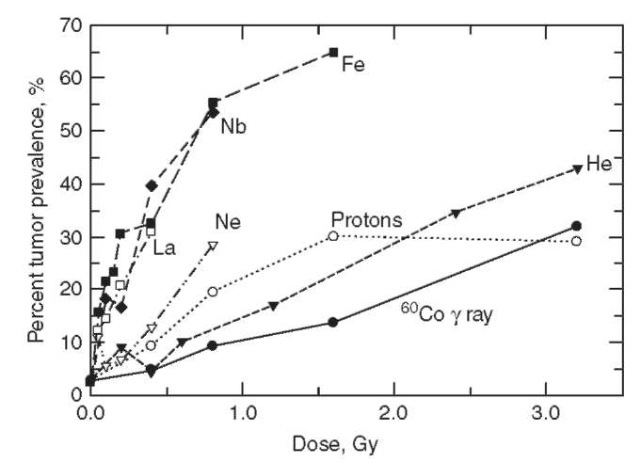
Figure 9. Tumor prevalence vs. dose for selected particles
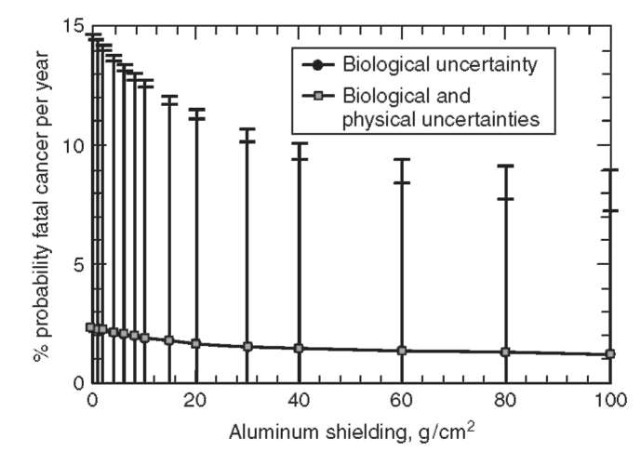
Figure 10. Probability of fatal, cancer incidence as a function of Al shielding thickness
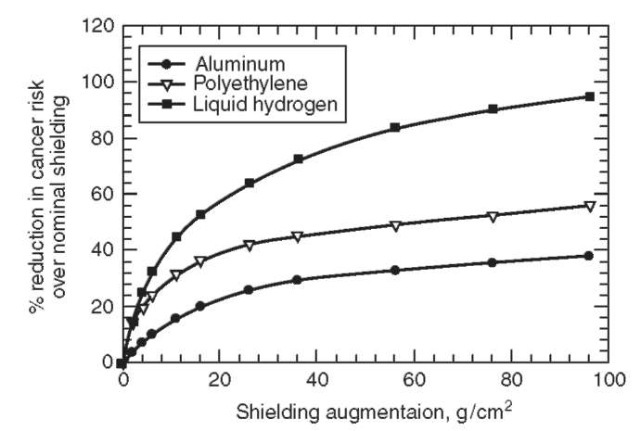
Figure 11. Reduction in cancer risk over nominal shielding as a function of shielding augmentation
Studies are in progress to determine optimal materials and combinations of materials that would reduce the dose equivalents within a spacecraft. Because of the potentially high levels of secondary neutrons, composite designs that include hydrogen-rich materials look particularly promising. Uncertainties in calculating the expected reduction in risk resulting from shielding and the material used for shielding are being reduced through current research to determine better the risks of carcinogenesis from the types of particles present in space (24). At the same time, research to examine pharmaceutical interventions that would reduce the consequences as well as the exposure are underway. Huso et al. (25) have preliminary data to suggest that Tamoxifen® administered during the promotion and progressive stages of cancer can reduce the incidence of mammary cancers in rats. This approach has the appeal of being administered only after an exposure (26). Kennedy et al. (26) and Lupton (27) are examining less toxic dietary supplements to reduce cancer, and Vazquez (28) is examining the effectiveness of drugs to reduce damage to the central nervous system.
Summary
The risk of cancer and other diseases arising from radiative exposures in space may be the major biomedical risk for missions of long duration because of the level of risk and the uncertainties of reducing such risks to acceptable levels. These risks arise primarily from exposures to galactic cosmic rays, particles from solar events, and particles trapped in Earth’s magnetic fields, in decreasing order of potential significance. Considerable progress has been achieved in characterizing the physical characteristics of the primary radiative fields that surround Earth and are also present in space. Less progress has been made in determining the biological risk of cancer per unit exposure for the different types of radiation and for the probable time periods. Our best estimates suggest unacceptable levels of risk, although what constitutes an acceptable risk for missions beyond Earth’s magnetosphere has yet to be defined. Research continues to make headway toward resolving the major issues, and few experts in the field doubt that safe interplanetary missions will be possible in the near future.
